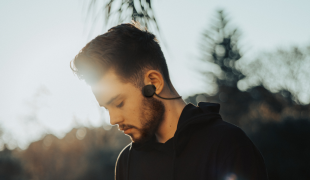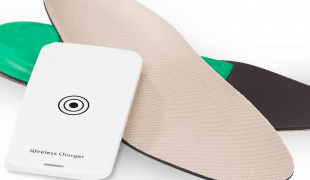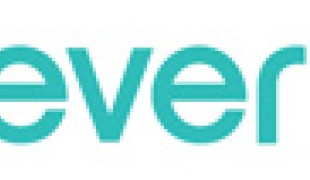- 2957
- 317
- 9
- 8
- 0
- Help Ukraine
About the solution
Michael Nicoletti is a retired army specialist who ended up losing his hearing gradually and insidiously over the course of a few years. The straw that broke the camel's back was the moment when he was watching TV, and his wife would set the volume for about 20, all while he could only begin to listen to anything that was being said at the 45 volume point.
He had a hearing problem, that was certain, and as an engineer himself, he needed to solve it. This is when he turned to a pantry staple: a simple drinking straw.
When looking at the straws, he began to think, what would happen if he cut one of those straws off? And so he did. He cut two pieces off, about an inch long, and stuck them in his ears, which allowed him to listen to the TV at the 20 volume set point. Unfortunately, this wasn't a permanent fix, and this is when he turned to Dr. Kent Flanagan, an audiologist who works at the Ralph H. Johnson VA Medical Centers in Charleston, South Carolina.
After getting the diagnosis of acquired atresia, a condition where the ear canal collapses, which Nicoletti had in both his ears, the doctor told him that the condition could be fixed surgically. After deciding that surgery wasn't an option, he decided to team up with Flanagan and develop their own device, using the straws as a starting point.
Within months, the stents were 3D printed and they were granted the Veterans Association's first compassionate use approval by the FDA, which means that they can only be used by Nicoletti, pending further research and clinical trials.
There are over a million veterans in the USA who suffer from hearing loss, whether it's due to noise exposure during military service, the normal changes that come with aging, or acquired conditions like Mr. Nicoletti's. There is a world of possibilities for this small, yet big solution.
Adapted from https://www.today.com/health/how-veteran-s-homemade-solution-becomes-3d-...
DISCLAIMER: This story was written by someone who is not the author of the solution, therefore please be advised that, although it was written with the utmost respect for the innovation and the innovator, there can be some incorrect statements. If you find any errors please contact the patient Innovation team via info@patient-innovation.com
https://www.youtube.com/watch?v=YEzVkdeTdpw
This solution shall not include mention to the use of drugs, chemicals or biologicals (including food); invasive devices; offensive, commercial or inherently dangerous content. This solution was not medically validated. Proceed with caution! If you have any doubts, please consult with a health professional.
-
-
573
-
0
-
10865

Pedro, an acoustic engineer designed an open-ear hearable device in order to allow everyone to listen to music!
COMMUNICATION: Communicating, whether by speaking, listening, or other means
Hearing Disorders
5 Senses support devices: (glasses, hearing aids, headphones...)
Assistive Technology access
Body-Worn solutions (Clothing, accessories, shoes, sensors...)
Regaining sensory function
Promoting self-management
Promoting inclusivity and social integration
Improving Speech and Communication
Raise awareness
General and Family Medicine
Internal Medicine
Neurology
Otorhinolaryngology
Denmark
-
-
-
411
-
2
-
9260

SmartSole GPS - Tracker for people with Alzheimer's, dementia and autism
COMMUNICATION: Communicating, whether by speaking, listening, or other means
WALKING: Walking
CAREGIVING
Alzheimer's Disease
Dementia (Alcoholic Dementia, Vascular Dementia)
Body-Worn solutions (Clothing, accessories, shoes, sensors...)
Difficulty coordinating movements
Loss of balance
Social withdrawal or isolation
Cognitive impairment
Memory loss
Irritability or anger outbursts
Confusion
Restlessness or feeling slowed down
Anxiety
Panic attacks
Difficulty controlling impulses
Mood swings
Feelings of guilt or worthlessness
Suicidal thoughts or behaviors
Hallucinations (perceiving things that aren't there)
Dizziness or lightheadedness
Fatigue
Restoring mobility
Promoting self-management
Building Supportive Community Relationships
Promoting inclusivity and social integration
Improving Speech and Communication
Preventing (Vaccination, Protection, Falls, Research/Mapping)
Raise awareness
Caregiving Support
Child and Adolescent Psychiatry
General and Family Medicine
Internal Medicine
Medical Genetics
Neurology
Pediatrics
Psychiatry
United States
-
-
-
331
-
0
-
4367

Clevermind, a dementia friendly interface for dementia patients created by a caring son
COMMUNICATION: Communicating, whether by speaking, listening, or other means
CAREGIVING
Social interaction
Dementia (Alcoholic Dementia, Vascular Dementia)
App (Including when connected with wearable)
Difficulty concentrating or making decisions
Social withdrawal or isolation
Loss of interest or pleasure in activities (anhedonia)
Promoting self-management
Building Supportive Community Relationships
Promoting inclusivity and social integration
Enhancing Mental Health
Improving Speech and Communication
Raise awareness
Caregiving Support
General and Family Medicine
Internal Medicine
Neurology
United States
-
 en
en